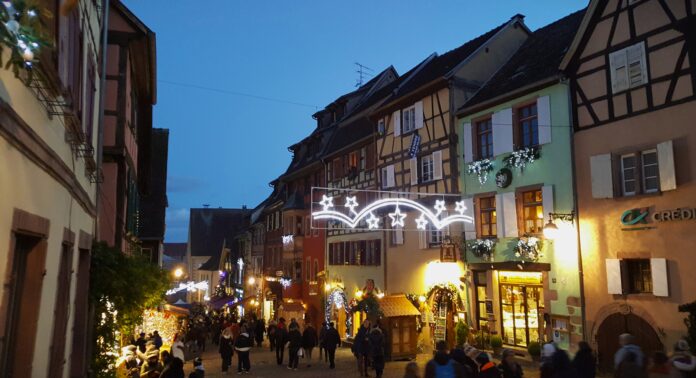European Christmas markets are a centuries-old tradition that bring warmth and cheer to the long dark nights of winter. A popular concept today, the practice goes back to back to the Middle Ages, and is believed to have originated in Germany.
In those earliest of days, villagers would gather on the street to showcase wares, offer handicrafts, and trade and barter food. The mission was to stock up on enough supplies to last the winter. Over time, the winter markets expanded with more offerings. Eventually evolving into the Christmas markets of the modern era.
Today, just about every mid-sized town in Germany and France (and plenty of other countries, too) has a Christmas market. They combine the excitement of open-air shopping with nostalgic traditional charm, mixed with enchantment from childhood memories.
For example, you’ll find luscious chestnuts roasting on an open fire (for real), decadently decorated gingerbread treats, and mouth-watering grilled goodness. Alongside handmade holiday ornaments, toys and trinkets, and soaps and lotions. Bountiful collections of one-of-a-kind finds for perfectly unique holiday gifts.
An ideal way to tour European Christmas markets is by river cruise. Because your accommodations go right along with you. AmaWaterways’ eight-day excursion on the Rhine spans four countries beginning in Basel, Switzerland, and ending in Amsterdam in The Netherlands. You’ll visit sleepy scenic regions known for colourful holiday traditions, and bustling cosmopolitan cities with iconic sites. All the while getting your fill of magical Christmas markets at every stop.
Markets in historic regions of France
In France’s historic Alcase region is the only town that fully survived destruction of World War II bombings. Riquewihr, surrounded by rolling hillside vineyards, is a quaint and beautiful medieval hamlet with only 1500 inhabitants. It looks essentially the same as it did back in the 16th Century, with architecture that appears unchanged. Stepping through the massive iron Dolder Gate is like stepping back to how a village would have looked 500 years ago.
Strasbourg has a German name, but is located in France. That’s because the city traded hands between French and German rule several times over the centuries. Consequently, it became a beautiful blend of both countries, architecturally and culturally. It’s home to the European Union Parliament, half-timbered black and white houses, and baroque sandstone buildings – all within blocks of each other. The entire town center was listed as a UNESCO World Heritage Site in 1988.
At the epicenter of Strasbourg is the monumental Cathédrale de Nôtre Dame, where stands one of the largest clocks in the world. The Astronomical Clock is considered a renaissance masterpiece, the result of a collaboration of artists, mathematicians and technicians. It dates back to 1842, with animated figures that emerge every day at half-past noon.
Picturesque markets in Germany
Firstly, the romantic city of Heidelberg is perfectly picturesque. Also, it’s Germany’s oldest university town, home to the Heidelberg University that was founded in 1386. The looming landmark Heidelberg Castle is one of Europe’s most important Renaissance-style structures north of the Alps. Nestled in the hillside 300 feet above the Neckar River and the red roofs of historic downtown, it overlooks the Old Stone Bridge, and the Haupstrasse, one of the longest pedestrian shopping streets in Germany.
With a natural harbor that has led to 2000 years of continuous habitation, Cologne is Germany’s fourth largest city. A major cultural center with a vibrant arts scene, its known for its charming historic district and 13th Century Gothic Cathedral – the tallest building in the world at the time of its completion. It, too, is a UNESCO World Heritage Site.
The Christmas market in Cologne is one of the largest in Germany. With close to 200 wooden pavilions to peruse, tasty treats to try, and melodic music in the air, it’s a wonderful way to spend a day. With plenty of Glühwein (hot mulled wine) to keep you warm, too.
Tis the season.







